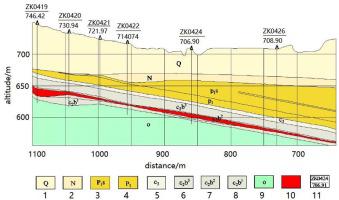当前位置:
X-MOL 学术
›
Ore Geol. Rev.
›
论文详情
Our official English website, www.x-mol.net, welcomes your feedback! (Note: you will need to create a separate account there.)
The Exploration of Sedimentary Bauxite Deposits Using The Reflection Seismic Method: A Case Study from the Henan Province, China
Ore Geology Reviews ( IF 3.3 ) Pub Date : 2020-12-01 , DOI: 10.1016/j.oregeorev.2020.103832 Guoqiang Xue , Zhiyuan Li , Wenbo Guo , Jingsheng Fan
Ore Geology Reviews ( IF 3.3 ) Pub Date : 2020-12-01 , DOI: 10.1016/j.oregeorev.2020.103832 Guoqiang Xue , Zhiyuan Li , Wenbo Guo , Jingsheng Fan

|
Abstract Sedimentary bauxite usually occurs in gently dipping or monoclinic folded formations. The roof of syncline bauxite tends to be flat and the bottom appears to be similar to a concave bucket. Until recently, mainly non-seismic geophysical exploration methods, such as gravity, magnetic, and electrical methods, have been used in the exploration of syncline bauxite deposits. However, both the thickness and depth of bauxite deposits can vary significantly. Therefore, gravity, magnetic, electrical, and other non-seismic methods have technical limitations, especially when planning exploration drill targets. By contrast, seismic methods have advantages in the exploration of concealed bauxite deposits due to their high vertical resolution. In this study, reflection seismics are adopted to detect bauxite layers in China’s Henan Province. It is observed that strong reflection interfaces (positive phases) appeared on the top surfaces of the bauxite layers. Meanwhile, weak reflection interfaces (both positive and negative phases are recorded) appeared on the upper surface of the lower overlying limestone layer. Seismic reflection methods cannot only define the shape and structure of the bauxite layers, but also indicating their relative depth and thickness, respectively. Importantly, subsequent exploration drilling confirmed our seismic interpretation.
更新日期:2020-12-01



























 京公网安备 11010802027423号
京公网安备 11010802027423号